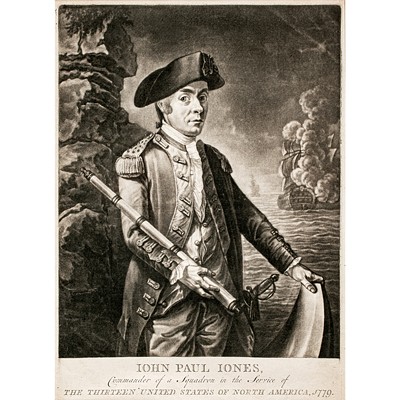1781 Dated Siege of Yorktown Revolutionary War Copper-Plate Map by David Ramsay
Lot 112
Categories
Estimate:
$600 - $900
Absentee vs Live bid
Two ways to bid:
- Leave a max absentee bid and the platform will bid on your behalf up to your maximum bid during the live auction.
- Bid live during the auction and your bids will be submitted real-time to the auctioneer.
Bid Increments
| Price | Bid Increment |
|---|---|
| $0 | $10 |
| $200 | $20 |
| $300 | $25 |
| $500 | $50 |
| $1,000 | $100 |
| $2,000 | $200 |
| $3,000 | $250 |
| $5,000 | $500 |
| $10,000 | $1,000 |
| $20,000 | $2,000 |
| $30,000 | $2,500 |
| $50,000 | $5,000 |
| $100,000 | $10,000 |
| $200,000 | $20,000 |
| $300,000 | $25,000 |
| $500,000 | $50,000 |
About Auction
By Early American History Auctions
Jan 23, 2021
Set Reminder
2021-01-23 12:00:00
2021-01-23 12:00:00
America/New_York
Bidsquare
Bidsquare : Early American History Auction of Autographs, Americana, Political & Maps
https://www.bidsquare.com/auctions/early-american-history-auctions/early-american-history-auction-of-autographs-americana-political-maps-6311
311 Lots of Rare, Historic Autographs, Americana, Civil War Era, George Washington, Abraham Lincoln, Slavery & Black History, Revolutionary War Era, Colonial America, Federal Period, War of 1812, Colonial Currency, Indian Peace Medals & more... Early American History Auctions auctions@earlyamerican.com
311 Lots of Rare, Historic Autographs, Americana, Civil War Era, George Washington, Abraham Lincoln, Slavery & Black History, Revolutionary War Era, Colonial America, Federal Period, War of 1812, Colonial Currency, Indian Peace Medals & more... Early American History Auctions auctions@earlyamerican.com
- Lot Description
American Revolution
1781 Siege & Battle of Yorktown Revolutionary War Map with Illustrations of George Washington, General Clinton, Count Rochambeaux, the Marquis de Lafayette, and Baron von Steuben's Headquarters and Locations
(1785) 1781-Dated Revolutionary War Period Map, "Plan of the Investment of York & Gloucester, by the Allied Armies: in Sept.r and Oct.r 1781" (a.k.a.... the Siege of Yorktown or the Battle of Yorktown), by David Ramsay (1747-1815), Extremely Fine.
Copperplate Engraving Map measuring about 8.5" x 9" from: David Ramsay's, The History of the Revolution of South Carolina..., Printed at Trenton, N. J., by Isaac Collins 1785. 1781-Dated Revolutionary War Era Map of the Battle of Yorktown, featuring emplacements of British, French, and American troops during this decisive battle that led the Americans to victory over the British in the Revolutionary War. The paper engraved printing is crisp and clear, and the overall appearance is excellent with just some trivial tone near the edge at bottom center. This historic Map measures 9" square and is ready for framing and display. This Map shows many warships in the York River, some sinking, others on fire. Significant points on the Map include the headquarters of George Washington, General Clinton, Count Rochambeaux, the Marquis de Lafayette, and Baron von Steuben. Perhaps the most important point on the Map is marked simply as, "The Field where the British laid down their arms." Also displayed is a numbered "key" at upper left that notes the emplacement of British cannon and howitzers and the location of warships that played important parts in the Battle of Yorktown. This scarce Map was originally bound into David Ramsay's "The History of the Revolutions of South Carolina," printed in 1785 by Isaac Collins, the top, left and bottom edges have been trimmed while the right edge is "as made" with its wide original selvage We note a similar example, untrimmed but stained and heavily toned for sale on the Internet at $1,450. This current example appears far superior with nice eye appeal.
The Siege of Yorktown, also known as the Battle of Yorktown, the surrender at Yorktown, or the German Battle, ending on October 19, 1781, at Yorktown, Virginia, was a decisive victory by a combined force of American Continental Army troops led by General George Washington and French Army troops led by the Comte de Rochambeau over a British army commanded by British peer and Lieutenant General Charles Cornwallis.
The culmination of the Yorktown campaign, the siege proved to be the last major land battle of the American Revolutionary War in the North American region, as the surrender by Cornwallis, and the capture of both him and his army, prompted the British government to negotiate an end to the conflict. The battle boosted faltering American morale and revived French enthusiasm for the war, as well as undermining popular support for the conflict in Great Britain.
In 1780, about 5,500 French soldiers landed in Rhode Island to help their American allies fight the British troops who controlled New York City. Following the arrival of dispatches from France that included the possibility of support from the French West Indies fleet of the Comte de Grasse, disagreements arose between Washington and Rochambeau on whether to ask de Grasse for assistance in besieging New York or in military operations against a British army in Virginia.
On the advice of Rochambeau, de Grasse informed them of his intent to sail to the Chesapeake Bay, where Cornwallis had taken command of the army. Cornwallis, at first given confusing orders by his superior officer, Henry Clinton, was eventually ordered to build a defensible deep-water port, which he began to do in Yorktown. Cornwallis' movements in Virginia were shadowed by a Continental Army force led by the Marquis de Lafayette.
The French and American armies united north of New York City during the summer of 1781. When word of de Grasse's decision arrived, both armies began moving south toward Virginia, engaging in tactics of deception to lead the British to believe a siege of New York was planned.
De Grasse sailed from the West Indies and arrived at the Chesapeake Bay at the end of August, bringing additional troops and creating a naval blockade of Yorktown. He was transporting 500,000 Silver Pesos collected from the citizens of Havana, Cuba, to fund supplies for the siege and payroll for the Continental Army. While in Santo Domingo, de Grasse met with Francisco Saavedra de Sangronis, an agent of Carlos III of Spain.
De Grasse had planned to leave several of his warships in Santo Domingo. Saavedra promised the assistance of the Spanish navy to protect the French merchant fleet, enabling de Grasse to sail north with all of his warships. In the beginning of September, he defeated a British fleet led by Sir Thomas Graves that came to relieve Cornwallis at the Battle of the Chesapeake. As a result of this victory, de Grasse blocked any escape by sea for Cornwallis. By late September, Washington and Rochambeau arrived, and the army and naval forces completely surrounded Cornwallis.
After initial preparations, the Americans and French built their first parallel and began the bombardment. With the British defense weakened, on October 14, 1781, Washington sent two columns to attack the last major remaining British outer defenses. A French column under Wilhelm of the Palatinate-Zweibrcken took Redoubt No. 9 and an American column under Alexander Hamilton took Redoubt No. 10.
With these defenses taken, the allies were able to finish their second parallel. With the American artillery closer and its bombardment more intense than ever, the British position began to deteriorate rapidly. Cornwallis asked for capitulation terms on October 17. After two days of negotiation, the surrender ceremony occurred on October 19; Cornwallis was absent from the ceremony.
With the capture of more than 7,000 British soldiers, negotiations between the United States and Great Britain began, resulting in the Treaty of Paris of 1783.
- Shipping Info
-
Early American provides in-house worldwide shipping. Please contact us directly if you have questions about your specific shipping requirements.
-
- Buyer's Premium



 EUR
EUR CAD
CAD AUD
AUD GBP
GBP MXN
MXN HKD
HKD CNY
CNY MYR
MYR SEK
SEK SGD
SGD CHF
CHF THB
THB




















